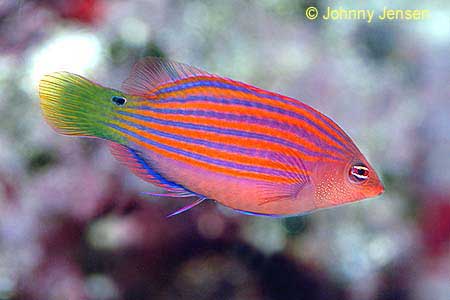|
|
Six Line Wrasse

The Six Line Wrasse is also referred to as the Sixline, the Sixstripe and the Pyjama Wrasse. It comes from the Indo-Pacific and
inhabits coral branches on the reef edges. It has a basic red/orange body with six sharp blue lines running horizontally across
the entire body. There is a dark eyespot at the base of the tail. Wrasses are referred to as cleaner fish, because of their
practice of cleaning parasites from other willing species. The Six Line is not as prone to cleaning as other wrasses, though.
The Six Line is a good fish for the intermediate aquarist, as they are disease resistant. They are
shy though and may be difficult to find in a tank. A 40 gallon tank is a possibility for a Six Line,
provided there aren't many other inhabitants. A tank of at least 55 gallons with plenty of hiding
places and a fine substrate is recommended. They will wedge themselves in rock work or bury themselves
in the sand at night for protection.
Six Lines will eat mysis shrimp, brine shrmip, krill, fish eggs, snails, urchins, shellfish, flake
foods and chopped fish. It benefits Tridacna clams by eating pyramidellid snails. The Sixline will
attack live shrimp. They should be fed a couple of times per day.
The males develops brighter coloring when it is read to breed. Males are also larger than females.
Eggs drift with the tide. Juveniles are all born female with some turning to males. Juveniles will
group together, but adults are solitary. Breeding in captivity is not yet documented.
| Scientific Name: |
Pseudocheilinus hexataenia |
| Family: |
Labridae |
| Care: |
Normal |
| Temperature: |
24 - 28 C; 75 - 82 F |
| pH: |
8.1 - 8.3 |
| dH: |
8 - 12 |
| Specific Gravity: |
1.020 - 1.025 |
| Size: |
10 cm; 4 inches |
| Breeding: |
Egg Layer |
| Life Span: |
10 years |
| Crustacean Safe: |
No |
| Coral Safe: |
Yes |
|
Compatibility:
|
|
Keep only one Pseudocheilinus in a tank. They are compatible with any fish, but tank mates to avoid are grammas, gobies, cardinals, eels, lionfish, large angels, triggers, other wrasses and shrimp. They will clean Tangs, such as the Regal and Yellow Tang. They tend to attack new tank inhabitants regardless of whether they are compatible with them in the long term.
|
|